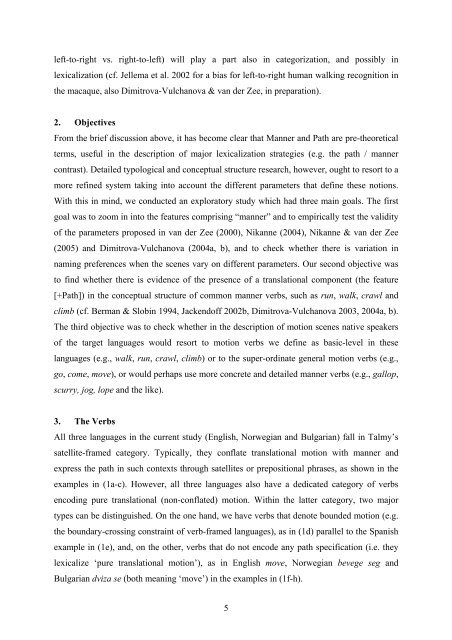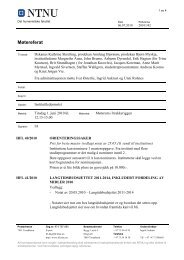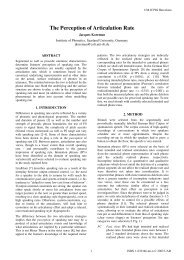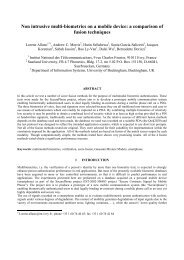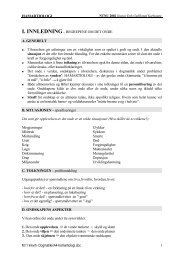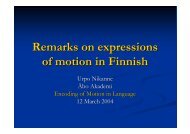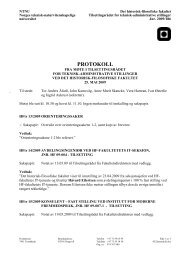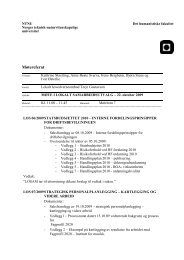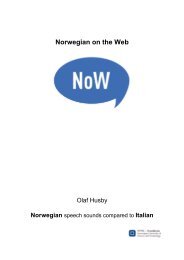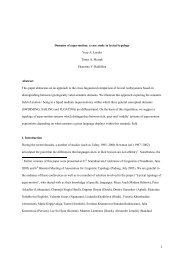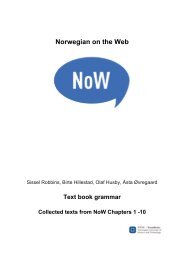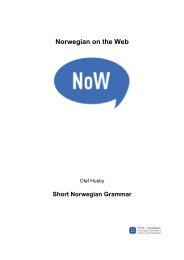In press: In: Dimitrova-Vulchanova, M - NTNU
In press: In: Dimitrova-Vulchanova, M - NTNU
In press: In: Dimitrova-Vulchanova, M - NTNU
You also want an ePaper? Increase the reach of your titles
YUMPU automatically turns print PDFs into web optimized ePapers that Google loves.
left-to-right vs. right-to-left) will play a part also in categorization, and possibly in<br />
lexicalization (cf. Jellema et al. 2002 for a bias for left-to-right human walking recognition in<br />
the macaque, also <strong>Dimitrova</strong>-<strong>Vulchanova</strong> & van der Zee, in preparation).<br />
2. Objectives<br />
From the brief discussion above, it has become clear that Manner and Path are pre-theoretical<br />
terms, useful in the description of major lexicalization strategies (e.g. the path / manner<br />
contrast). Detailed typological and conceptual structure research, however, ought to resort to a<br />
more refined system taking into account the different parameters that define these notions.<br />
With this in mind, we conducted an exploratory study which had three main goals. The first<br />
goal was to zoom in into the features comprising “manner” and to empirically test the validity<br />
of the parameters proposed in van der Zee (2000), Nikanne (2004), Nikanne & van der Zee<br />
(2005) and <strong>Dimitrova</strong>-<strong>Vulchanova</strong> (2004a, b), and to check whether there is variation in<br />
naming preferences when the scenes vary on different parameters. Our second objective was<br />
to find whether there is evidence of the presence of a translational component (the feature<br />
[+Path]) in the conceptual structure of common manner verbs, such as run, walk, crawl and<br />
climb (cf. Berman & Slobin 1994, Jackendoff 2002b, <strong>Dimitrova</strong>-<strong>Vulchanova</strong> 2003, 2004a, b).<br />
The third objective was to check whether in the description of motion scenes native speakers<br />
of the target languages would resort to motion verbs we define as basic-level in these<br />
languages (e.g., walk, run, crawl, climb) or to the super-ordinate general motion verbs (e.g.,<br />
go, come, move), or would perhaps use more concrete and detailed manner verbs (e.g., gallop,<br />
scurry, jog, lope and the like).<br />
3. The Verbs<br />
All three languages in the current study (English, Norwegian and Bulgarian) fall in Talmy’s<br />
satellite-framed category. Typically, they conflate translational motion with manner and<br />
ex<strong>press</strong> the path in such contexts through satellites or prepositional phrases, as shown in the<br />
examples in (1a-c). However, all three languages also have a dedicated category of verbs<br />
encoding pure translational (non-conflated) motion. Within the latter category, two major<br />
types can be distinguished. On the one hand, we have verbs that denote bounded motion (e.g.<br />
the boundary-crossing constraint of verb-framed languages), as in (1d) parallel to the Spanish<br />
example in (1e), and, on the other, verbs that do not encode any path specification (i.e. they<br />
lexicalize ‘pure translational motion’), as in English move, Norwegian bevege seg and<br />
Bulgarian dviza se (both meaning ‘move’) in the examples in (1f-h).<br />
5


